Women or Men – Who is a better leader?
What does it mean to be a good leader? What does a leader’s profile look like? Is the leader authoritative, determined and fearless? Or maybe he/she is persistent, tactful and dedicated?
Where did we get the idea of leaders at all? Most likely from ancient Greek and Roman times from military leaders, through royal families to statesmen. When we mention this, we immediately get the image of a man who controls everything, and the others, hierarchically lower positioned, almost without the possibility of opposition, listen and follow. In modern times, the military has been given a different role, but business leadership systems still copy the hierarchical structures.
Society has come a long way and only in the last twenty years has gender equality in the workplace been discussed in modern, developed countries. This should ensure equality in the labour market and give companies a choice to find the best possible leaders to increase productivity. Productivity is the key word, because this is not a political debate on gender equality, but an analysis of the leaders of the new age.
This text will present the results of some recent research that indicates that women are perceived as better leaders, but the actual results cannot be known until women are really given the same opportunity as men.
It should also be borne in mind that each age brings changes and different needs, so different ways of leadership may be needed in different circumstances and times. With all the objectivity and restraint, it is obvious that the idea that the 21st century is a time that requires increased involvement of women is still strongly imposed.
A recipe for a good leader
a. Positive expectations and attitude, optimism – this refers to the attitude towards oneself and team performance and leads to a high level of performance. Leaders simply radiate (self) confidence – in themselves and their team.
b. Justice – It is extremely important that the leader is fair, completely impartial, especially in awarding prizes and recognitions. Righteous leaders have no hidden intentions and people know exactly what to expect from them and what expectations they need to meet in return.
c. Authenticity – the best leaders are those who have good relationships with followers and who have built those relationships not out of position but out of the will of followers to follow them out of trust and their simplicity and authenticity.
d. Good communication – it seems very easy, but it is not. Good leaders communicate effectively and constantly. They inform, clarify and connect. They don’t assume that if they once said they all understood. Repetition is important. In addition, good communication is the foundation of all other behaviors – the leader needs to communicate positive expectations and attitudes, clearly explain policy actions and arguments, and develop good, strong interpersonal relationships with those he leads, which means constantly seeking feedback.
This recipe may seem subjective, so it should be said what research shows. Namely, research shows that women are more likely to possess the qualities needed for leadership that is associated with success. Women are ready and have a better ability to transform and adapt, care more about the development of their followers, are better listeners, easier to encourage followers to think “outside the box” and inspire them and have higher ethical standards.
Dr. Bass, who developed the theory of transformational leadership, predicts that in the future, women leaders will dominate because they are more suited to governing the 21st century than men. The research sublimates the common traits of talented and confident women leaders in seven essential categories:
1. They give great value to relationships and the success of their organizations is based on the quality of relationships within them
2. They like direct communication
3. They love diversity and believe that it brings added value to their team
4. When it comes to the structure of their organization, they prefer to lead from the center rather than from the top
5. They are sceptical of a hierarchy that includes arrogance and gaining advantage just because of the position within it
6. They have a broader picture of the work they do, because they are interested in it, so they ask such questions
7. They are more loyal and committed
What is the real situation on the labor market?
At the lowest level, more than half of the employees in the organizations are women. As we climb to higher levels of organization, the number of women is declining. The disturbing fact is that the percentage of women in senior leadership roles in businesses has remained relatively steady since we conducted our original research. Only 4.9% of Fortune 500 CEOs and 2% of S&P 500 CEOs are women.
Zenger Folkman, a consulting firm, examined women’s effectiveness in leadership and representation in corporate America ten years ago and one year ago, the results of which were first published in the Harvard Business Review. For more than a decade, Zenger Folkman has been collecting so-called 360 ° feedback data from leading organizations around the world. It is about assessing abilities and results, feedback given by colleagues, differently ranked, i.e., hierarchically at the same level, higher and lower. They have more than 450,000 documents regarding about 45,000 leaders, covering a wide range of industries. Although statistics vary around the world, this is an extremely consistent sample.
Between March and June last year, 454 men and 366 women were assessed on their leadership effectiveness using our Extraordinary Leader 360-degree assessment. Consistent with their pre-pandemic analysis, they found that women were rated significantly more positively than men. Comparing the overall leadership effectiveness ratings of men versus women, once again women were rated as more effective leaders (t-Value 2.926, Sig. 0.004). The gap between men and women in the pandemic is even larger than previously measured, possibly indicating that women tend to perform better in a crisis.
Women were rated more positively on 13 of the 19 competencies in our assessment that comprise overall leadership effectiveness. Men were rated more positively on one competency — technical/professional expertise — but the difference was not statistically significant.
In the table below, percentile scores for men and women are displayed sorted by the average rating for women based on data gathered in the first wave of the pandemic.
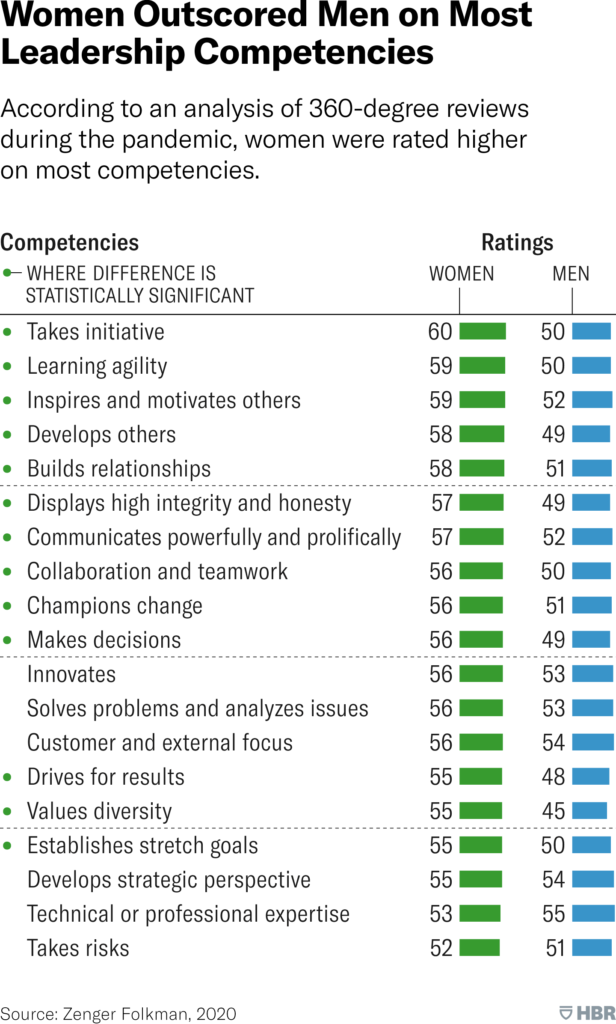
Why Are Women Leaders Seen as More Effective?
Each leader we assessed also received an employee engagement score based on their direct report’s responses to questions about how satisfied and committed they felt. The engagement level of those working for male leaders was slightly below average, but the engagement scores for the direct reports of female leaders were significantly higher. The overall average for both male and female leaders was the 51st percentile.
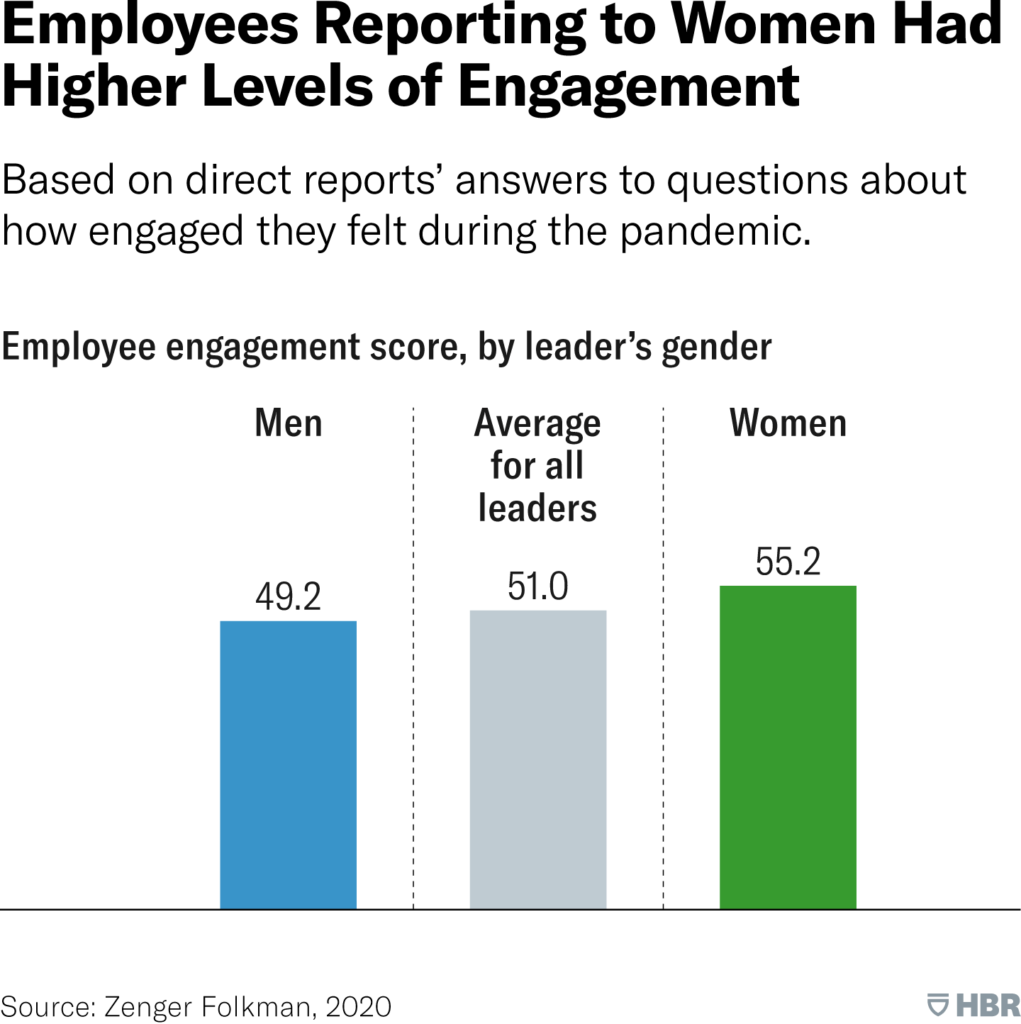
When crisis greater importance is put on interpersonal skills, such as motivation, inspiration, collaboration, relationship building.
What makes a difference in management effectiveness?
When answered by women, they said the answer lies in the fact that for the same recognition and award they have to do twice as much as men, never make mistakes and constantly prove their competence.
There is another very important reason, it seems, and it refers to the communication component, explained in the recipe for a good leader, earlier in this paper. When looking at the results in the section called “Practicing self-development”, which refers to seeking feedback on one’s own competence and the changes made based on the feedback received. It is a known fact that most people at the beginning of their careers are motivated to seek feedback and take measures to improve, but over time most people find that they gain enough ability to stop asking for feedback. The results are quite similar until the age of forty, but then women keep the habit of asking for feedback and taking action to improve while men assume they are doing well and do not need feedback. If we take into account the fact that competence actually falls for everyone as age grows, this is a very important point.
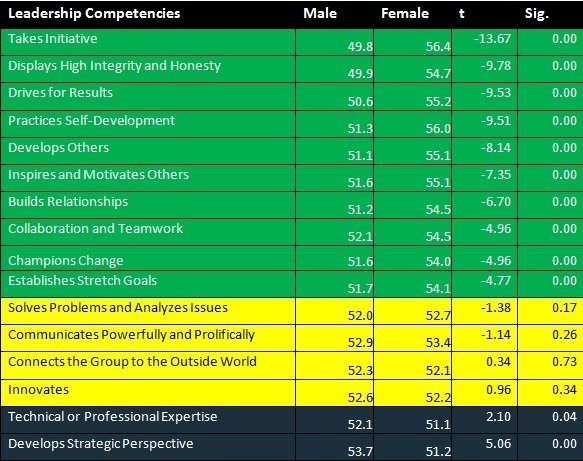
In fact, it is evident that women are seen as more efficient in their desire to accomplish tasks, achieve results, and be role models that actually describes leaders who take on challenges, ensuring that men work with integrity in performing challenging tasks. The pattern of behaviors and facts studied become even more intriguing by analyzing the different functional areas within the organization. This is what the collected data shows:
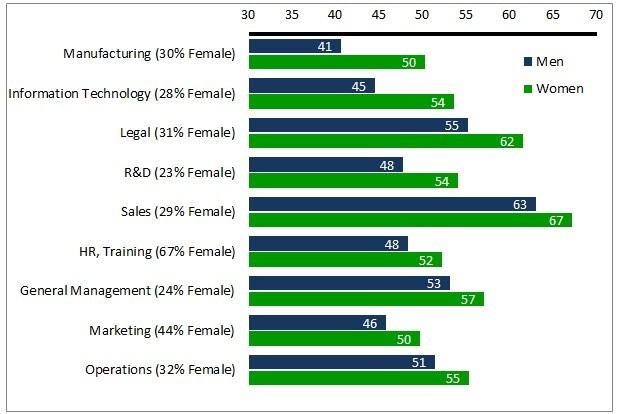
The data presented also show that many of our stereotypes are inaccurate, as women are rated higher for efficiency in traditionally male areas such as engineering, sales, law, or information technology.
What about differences in level in the organization? Research shows that the more women are positioned in an organization, the greater the perception of their effectiveness.
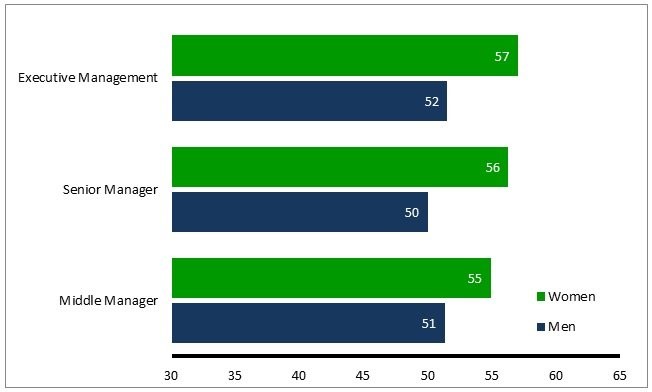
What can we conclude?
Dr. Gordon Curphy, one of the leading advisors to industrial and organizational psychology, argues that there has been a general collapse of society’s trust in our leaderships leading to multi-level crises. According to Curphy, this can be largely attributed to the widespread inability of leaders to build a cohesive team oriented towards results. He further believes that women find it easier to achieve this, because by nature they are more oriented towards cooperation and relationships, so it is easier to create and maintain. The problem is that men are given many more opportunities for high-ranking positions, so it was of great importance to bring Ms. Mary Barr to the CEO of General Motors, as it is a male-oriented industry in which women can possibly be found in the positions of human resources director.
Today, it is pointless to discuss the concept of the glass ceiling, because too much research proves that it really exists and many governments, at least declaratively, deal with its breaking, and many scientists deal with its causes. The glass ceiling represents informal obstacles that prevent minorities from advancing, i.e., situations in which the advancement of a qualified person in the hierarchy is prevented due to some form of discrimination. Although the term glass ceiling refers to all minorities, it is most often associated with women.
But to conclude, being a man or a woman does not guarantee the ability to build and lead a team that achieves results. Believing stereotypes created from assumptions about someone based on gender traits should be a thing of the past. Women should be judged as professionals (asexual type) and all should have the same starting position from which they can show and prove their competence and ability.

